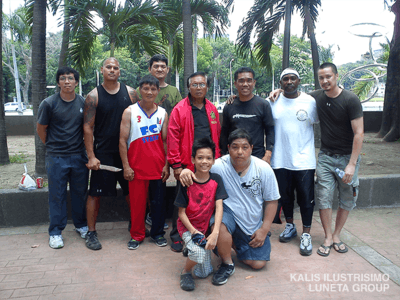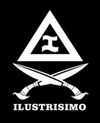Kalis Ilustrisimo
|
logo |
Kalis Ilustrisimo (formerly known as Kali Ilustrisimo) is a blade-based Filipino Martial Art (Eskrima) founded by Antonio "Tatang" Ilustrisimo.
Name
Referred to simply as Escrima by the founder and previous generations of his family, it is also known in the Cebu region where it hails from as Olisistrisimo Escrima, a portmanteau of olisi (one of the Filipino terms for stick) and the surname of its practitioners, Ilustrisimo. In Manila, it was known as Ilustrisimo Arnis[1]
During the mid 1980s, after the term Kali for Filipino Martial Arts became popular, the system began to be referred to as Kali Ilustrisimo.
In latter years, as the term kali for FMA became embroiled in controversy as modern research could not find it in local usage the Philippines (arnis and escrima being the more common terms), the name of the art as practiced by Tatang was officially changed to Kalis Ilustrisimo in order to be more appropriate: kalis (or keris) being another term for sword/blade as the art of Tatang is more blade-oriented than stick-oriented. To be clear, Filipinos do not have a weapon called "sword". It is only a term used for westerners to understand and to have a name for Filipino blades.
History

The Ilustrisimo clan from Bantayan Island in the Northern part of the Cebu region was known for their Eskrima and has practiced its own traditional stick and sword fighting style for over five generations. Its first known practitioner was Pablo Ilustrisimo who passed it on to Juan de Dios Ilustrisimo, who then passed it to Isidro Ilustrisimo, to Melecio Ilustrisimo and to Regino Ilustrisimo. Although Tatang was taught by father Isidro Ilustrisimo and practiced his family style in his boyhood, he lived a long storied life and developed his own personal fighting style from his different teachers, compatriots, experiences and subsequent travel as a seaman, during which he faced numerous duels, challenges as well as "deathmatches" with live blades. Family members that Tatang taught were his cousin Floro Villabrille (1912-1992) and his grandnephew Samuel Ilustrisimo.
For more information, see the main article on Antonio Ilustrisimo.
Throughout most of his latter life, Tatang was secretive about his methods of fighting for they had kept him alive and undefeated for decades. It was only in 1976 that Tatang started teaching his evolved style to "outsiders", with Antonio "Tony" Diego (1946-2014) and Epifanio "Yuli" Romo as his first students in Manila where he had migrated. Other notable students were Timoteo Maranga (during Ilustrisimo's younger days), Christopher "Topher" Ricketts(1955–2010), Romeo Macapagal, Pedro Reyes, Edgar Sulite (1957-1997), Rey Galang, Norman Suanico, Inocencio Glaraga, Roberto Morales, Ernesto Talag and Mark Wiley.[1] Even at his advanced age, Tatang was well-respected as a fighter in the tough streets of Tondo where he resided. As a testament to his reputation, archive footage of Ilustrisimo taken well into his 80s show his speed, control, timing and accuracy with sticks, blades as well as empty hand disarms against live blades even with his poor eyesight.
After Grand Master Tatang Ilustrisimo's death in 1997, Tony Diego was elected the head of Kalis Ilustrisimo.
Today, there are several organizations that continue to teach and propagate Tatang's art in part or in its entirety, like Kalis Ilustrisimo Repeticion Original headed by Tony Diego, Bahad Zu'bu by Yuli Romo, Kali Combatant by Pedring Romo, Bakbakan International by Topher Ricketts & Rey Galang, Tagpas Kalis Ilustrisimo by Romy Macapagal, Luneta Kali Ilustrisimo by Pedro Reyes & Samuel Ilustrisimo and Olistrisimo Eskrima with Roberto Morales.[1] Grandmaster Diego died on August 25, 2014.[2] He named Tom Dy Tang as his successor in Kali Ilustrisimo Repeticion Original.
References
- ↑ 1.0 1.1 1.2 The Secrets of Kalis Ilustrisimo: The Filipino Fighting Art Explained, Antonio Diego & Christopher Ricketts, 1999, Tuttle Publishing
- ↑ Romeo Macapagal (August 30, 2014). "Tribute and tribulation". Manila Times.
Bibliography
- Mark V. Wiley (1997). Filipino Martial Culture, ISBN 0-8048-2088-0.
- Mark V. Wiley (2000). Filipino Fighting Arts: Theory and Practice, ISBN 0-86568-180-5.
- Antonio Diego/Christopher Ricketts (2002) The Secrets of Kalis Ilustrisimo, ISBN 0-8048-3145-9.
